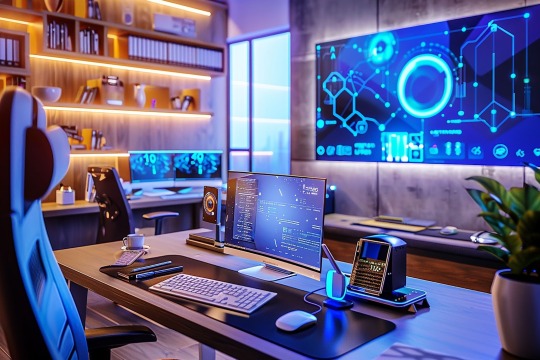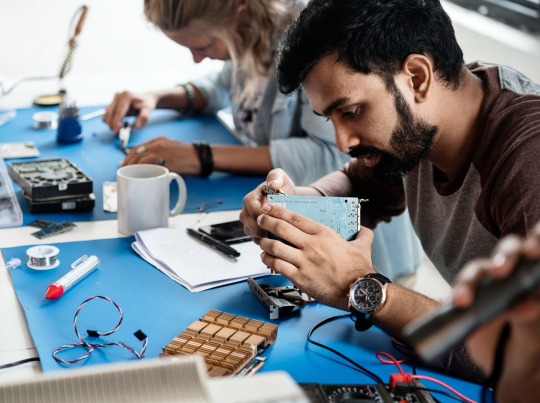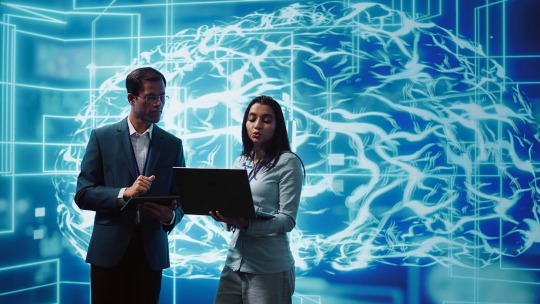#IoT platform
Text
#iot platform#iotnbo#web development#iot#software development#bluetooth#iot applications#iotsolutions#innovation#iot development services
2 notes
·
View notes
Text

🌟 Exciting News from Opulance Technologies! 🌟
Introducing our latest invention: the Advanced Automated Weather Station. This cutting-edge technology delivers real-time, accurate weather data to help you stay ahead of the elements. Perfect for meteorologists, farmers, and weather enthusiasts alike. Discover the future of weather monitoring with Opulance Technologies! 🌦️🔬 #OpulanceTech #WeatherStation #Innovation #RealTimeData #WeatherMonitoring
#iot development services#iot platform#iot tech#iotinnovation#iot in agriculture#robotics#tech#lgbt#iotdevices
2 notes
·
View notes
Text
Revolutionizing Business with IoT: Comprehensive Services and Monitoring Solutions
In today's fast-paced digital era, the Internet of Things (IoT) is transforming the way businesses operate. At RadiantEdge, we understand the immense potential of IoT and are committed to helping businesses in Dubai and beyond leverage this technology to drive innovation, streamline operations, and enhance productivity.
Why IoT is the Future of Business
The Internet of Things refers to the interconnection of everyday devices to the internet, allowing them to send and receive data. This technology enables businesses to automate processes, improve efficiency, and make data-driven decisions. From smart factories to intelligent supply chains, IoT is the backbone of the modern digital transformation... Explore More...
RadiantEdge's Comprehensive IoT Services in Dubai
As leaders in the IT industry with over two decades of experience, RadiantEdge is proud to offer a wide range of IoT services tailored to meet the specific needs of businesses in Dubai. Our IoT services in Dubai include:

IoT Strategy Development: We work closely with our clients to develop a customized IoT strategy that aligns with their business goals. This includes identifying key opportunities, selecting the right IoT platforms, and designing a roadmap for implementation.
IoT System Design and Integration: Our team of experts designs and integrates IoT systems that connect various devices and sensors, enabling seamless communication and data exchange. We ensure that these systems are scalable and secure, allowing businesses to grow and adapt to changing market conditions.
IoT Implementation and Deployment: From pilot projects to full-scale deployments, RadiantEdge manages every aspect of IoT implementation. We ensure that the transition to IoT is smooth and that systems are operational with minimal disruption to business activities.
Custom IoT Solutions: We understand that every business is unique, which is why we offer customized IoT solutions. Whether it's a smart building, connected vehicles, or an intelligent supply chain, we develop solutions that are tailored to your specific industry and business requirements.
IoT Monitoring: Ensuring Optimal Performance
One of the critical aspects of IoT is ensuring that all connected devices and systems are functioning optimally. Our IoT monitoring solutions are designed to provide real-time insights into the performance of your IoT ecosystem. With advanced analytics and proactive alerts, businesses can monitor the health of their IoT networks, identify potential issues, and take corrective actions before they escalate.
Key Features of Our IoT Monitoring Solutions:
Real-Time Data Analytics: Gain actionable insights from your IoT devices with real-time data analytics. Monitor key performance indicators, track trends, and make informed decisions to optimize operations.
Proactive Alerts: Our monitoring systems are equipped with intelligent alert mechanisms that notify you of any irregularities or potential issues. This allows for timely intervention, reducing downtime and ensuring continuity of operations.
Scalability: As your business grows, so does your IoT network. Our monitoring solutions are designed to scale with your business, providing consistent performance and reliability.
Security and Compliance: IoT security is paramount. We ensure that your IoT systems are protected against cyber threats and comply with industry standards and regulations.
The RadiantEdge Advantage
Choosing RadiantEdge for your IoT services in Dubai means partnering with a team of professionals who are dedicated to your success. Our expertise, combined with our commitment to innovation, makes us the ideal partner for businesses looking to embrace the future of technology.
Experienced Team: With over 20 years in the IT industry, our team has the knowledge and expertise to deliver high-quality IoT solutions.
Customer-Centric Approach: We prioritize our clients' needs and work closely with them to deliver solutions that drive results.
Global Reach: While based in the vibrant town of Nashik, we serve clients across the globe, delivering cutting-edge technology solutions.
Conclusion
The future of business lies in the Internet of Things. At RadiantEdge, we are committed to helping businesses in Dubai and beyond unlock the full potential of IoT. From strategy development to monitoring and maintenance, our comprehensive IoT services ensure that your business stays ahead in a rapidly evolving digital landscape.
Ready to revolutionize your business with IoT? Contact RadiantEdge today to learn more about our IoT services and how we can help you achieve success.
1 note
·
View note
Text
What is IoT ?
The Internet of Things (IoT) is the network of objects equipped with sensors, software, and other technology that enables communication and data sharing over the internet with other systems and devices. These "things" range from simple household items to extremely advanced industrial tools. Here is a brief summary:
1. Items and Tools: These can range from factory equipment to health gadgets such as activity monitors and home gadgets like lamps, fridges, and thermostats. The cat chased the mouse around the house.
2.Connection: Using the internet, Internet of Things (IoT) devices are able to establish communication with other systems and devices. This is frequently accomplished by utilizing cellular, Wi-Fi, or Bluetooth networks.
3.Data Gathering: Sensors in Internet of Things (IoT) devices gather data (such as heat, motion, heart rate) that can be used to produce insights or trigger automated actions.
4. The utilization of numerous IoT devices enables automation to take place. Instances of automation include issuing maintenance alerts when a machine malfunctions or activating lights upon entering a room. Smart homes allow for remote control of lighting, security, and appliances. Healthcare: Monitoring patients' vitals remotely using wearable devices.
5. IoT includes predictive maintenance, supply chain management, and manufacturing optimization within the industry. Intelligent irrigation systems for farming that adjust their actions based on soil and weather conditions. In "smart cities," effective management is applied to transportation, waste, and energy systems.
The Internet of Things ecosystem is rapidly growing, providing easy access to real-time data for informed decision-making in various industries.
#engineering college#engineering student#iot applications#iot#iot platform#iotsolutions#iot development services#techtrends
0 notes
Text
Transforming Industrial Operations with WideSky for Industry
Using data efficiently is just as crucial for staying ahead in the quickly changing world of industrial operations as speed and efficiency. The goal of WideSky cloud’s solution, WideSky for Industry, is to empower the industrial sector by streamlining operating procedures and data management. With this technology, industries may confidently and easily transition to digital transformation by integrating it with their current infrastructures.
What is WideSky for Industry?
Using data efficiently is just as crucial for staying ahead in the quickly changing world of industrial operations as speed and efficiency. WideSky Cloud’s solution, WideSky for Industry, aims to empower the industrial sector by streamlining its operating procedures and data management. With this technology, industries may confidently and easily transition to digital transformation by integrating it with their current infrastructures.
Important WideSky Features for Industry
Seamless Connectivity: The fundamental function of WideSky for Industry is to guarantee the interconnectedness of all devices and sensors, providing a single platform for the reliable and consistent collection of data across all processes.
Real-time Data Analytics: The platform offers real-time data analysis tools that let managers act fast to prevent interruptions and seize opportunities as they present themselves.
Predictive Maintenance: By predicting equipment breakdowns ahead of time with predictive analytics, WideSky for Industry may drastically cut downtime and maintenance expenses.
Energy Efficiency: The solution’s energy monitoring tools assist in spotting trends and places where energy use can be cut, resulting in more environmentally friendly operations.
Dashboards that users can customize to show pertinent metrics can make things easier.
WideSky Applications in the Industry
WideSky for Industry is flexible and can be used in various contexts and industries.
Manufacturing: WideSky for Industry assists in streamlining production schedules, preserving equipment health, and effectively managing inventories, from assembly lines to supply chain management.
Utilities: To enhance service dependability and regulatory compliance, this technology provides utility businesses with enhanced grid management capabilities, outage prediction, and customer usage analytics.
Mining: WideSky for Industry improves environmental monitoring, equipment tracking, and safety protocols in the mining industry — all vital for efficiently administrating mining operations.
Robust, scalable, and efficient technology solutions are essential as businesses change. In addition to being a tool, WideSky for Industry is a partner on an industry’s path to operational excellence and digital maturity. Companies can meet the difficulties of the present and take advantage of the opportunities of the future by utilizing the capabilities of WideSky for Industry.
Finally, WideSky for Industry is a forward-thinking solution to established industrial problems and gives a robust platform for sectors prepared to welcome the digital revolution.
0 notes
Text
How Full Stack and IoT Development Are Shaping Sweden’s Future 🌟
Hey Tumblr! 👋
Sweden is leading the way in tech innovation, and two major players in this scene are Full Stack Development and IoT (Internet of Things). Let's dive into how these technologies are transforming cities and industries across Sweden! 🇸🇪🚀
What’s Full Stack Development?
Full Stack Development means working on both the front-end (what users see) and back-end (the server-side stuff) of applications. In Sweden, from Stockholm to Malmö, businesses are hiring full-stack developers to build seamless, user-friendly platforms.
Why it matters: It’s about creating complete solutions that can adapt to the latest tech trends like AI and IoT.
The Magic of IoT in Sweden
IoT is making our cities smarter and our industries more efficient. Think smart sensors that track air quality in Stockholm or connected devices that help farmers in rural Sweden get real-time data.
Cool Fact: In Gothenburg and Malmö, IoT is used to monitor manufacturing processes and predict equipment maintenance. It's all about staying connected and informed.

Real-Life Examples 🚀
Healthcare: IoT devices improve patient monitoring and care, while full-stack solutions make data accessible and actionable.
Smart Homes: Imagine controlling your lights, thermostat, and security system from one app—thanks to IoT and full-stack development!
Sustainable Agriculture: IoT sensors help farmers optimize crops and save resources. Full-stack platforms turn that data into actionable insights.
Why You Should Care 💡
As Sweden pushes forward with sustainable and smart solutions, understanding and adopting Full Stack Development and IoT can put businesses at the forefront of innovation. Whether you’re a tech enthusiast or a business owner, these technologies are shaping our future!
Learn More About Us 🌐
At TechDev.se, we’re all about creating cutting-edge solutions with Full Stack Development and IoT. Check out our website to see how we can help your business innovate and grow!
Visit TechDev.se
Join the Conversation!
What are your thoughts on Full Stack Development and IoT? Have you seen these technologies in action? Share your ideas and experiences in the comments! 💬👇
#Full Stack Development#IoT#Tech Innovation#iot platform#iotsolutions#innovation#techinnovation#iot development services#digitaltransformation#iot applications#datamanagement#Smart Cities#Sweden Tech
1 note
·
View note
Text
The future of IoTx Coin hinges on a combination of technological progress, strategic alliances, regulatory clarity, and market adoption. While there are inherent risks, the potential for substantial growth exists if these factors align favorably. For those considering an investment in IoTx Coin, staying abreast of these developments is crucial.
Stay ahead of the curve with the latest insights and trends in software engineering technology and leadership by visiting our blog at atozofsoftwareengineering.blog.
For more in-depth discussions and expert opinions, follow our videos at https://youtube.com/@atozofsoftwareengineering.
#youtube#iot#iotx#iotx coin#iot investment#iot trends#iot platform#technology#infomation techology#software#software engineer#software engineering#software developer#software development#education#educational
1 note
·
View note
Text
Top 5 Tips for Learning IoT and AI

As we navigate the evolving landscapes of IoT and AI, it’s essential we establish a strong foundation in programming languages like Python and Java. Engaging in hands-on projects not only solidifies our understanding but also bridges the gap between theory and practice. By connecting with online communities, we can share insights and resources that enhance our learning. However, staying updated on industry trends and exploring real-world case studies are equally crucial. So, what are the specific strategies we can employ to maximize our efforts in these areas?
Build a Strong Programming Foundation

While we dive into the realms of IoT and AI, it’s crucial to build a strong programming foundation. Having solid programming skills not only aids in understanding complex algorithms but also equips us to handle data effectively. We should start by mastering languages like Python and Java, as they’re widely used in both fields.
Data analysis is equally important, so familiarizing ourselves with libraries like Pandas and NumPy will enhance our ability to manipulate and interpret data.
Next, we need to define clear objectives for our projects. Establishing SMART goals helps us stay focused and measure our progress. Identifying relevant data sources is essential too—both internal and external—ensuring we gather high-quality data for training AI models.
As we collect data, let’s pay attention to cleaning and preprocessing techniques, as these steps significantly impact the performance of our models.
Lastly, we should engage with online communities and forums. Collaborating with peers not only enriches our learning experience but also exposes us to diverse perspectives.
Engage in Hands-On Projects

Engaging in hands-on projects is one of the most effective ways to deepen our understanding of IoT and AI. By applying theoretical knowledge, we can see how these concepts play out in real-world scenarios.
Let’s start by building small projects that incorporate IoT devices, like using sensors to track environmental conditions or automating tasks within our homes. This practical application helps us grasp the mechanics behind these technologies.
As we progress, we can explore more complex setups, such as creating smart classrooms. Imagine using IoT-enabled projectors and interactive whiteboards to enhance collaborative learning. These projects not only solidify our skills but also demonstrate the power of IoT in educational environments.
Moreover, we shouldn’t shy away from experimenting with AI algorithms. By developing simple machine learning models, we can analyze data and gain insights into how AI interprets information. This hands-on experience encourages creativity and problem-solving, essential skills in this evolving field.
Ultimately, engaging in hands-on projects empowers us to bridge the gap between theory and practice, making our journey in IoT and AI both exciting and impactful.
Let’s dive in and start building!
Join Online Communities

In today’s digital age, joining online communities can significantly enhance our learning experience in IoT and AI. These platforms provide exclusive access to structured courses and resources that cater to our specific learning needs.
We can participate in live learning sessions with top educators, allowing us to interact directly with experts and fellow learners.
Networking opportunities abound within these communities. We can connect with diverse individuals who share our interests, fostering collaboration and support.
Engaging in discussions and exclusive chat groups enriches our understanding and exposes us to different perspectives, greatly benefiting our learning journey.
Moreover, many online communities offer certification upon course completion, which we can showcase on platforms like LinkedIn. This recognition enhances our professional credibility and supports our career advancement.
Stay Updated on Trends

Staying on top of trends in IoT and AI is essential for anyone looking to thrive in these rapidly evolving fields. We need to recognize the staggering growth projections, like the IoT market reaching $650 billion by 2026 and the expected 30.9 billion active IoT devices. This rapid expansion means we must continuously educate ourselves about emerging technologies and industry shifts.
We should pay attention to key trends, such as the ongoing chip shortage impacting IoT investments, with many semiconductor executives predicting supply chain improvements. Additionally, as IoT devices proliferate, security becomes a pressing concern. Staying informed about new regulations and security measures will help us navigate this landscape effectively.
We must also explore how AI is increasingly intertwined with IoT, providing real-time insights and enhancing decision-making across various sectors. By keeping up with research, attending webinars, and reading relevant publications, we can ensure our knowledge remains current and applicable.
In this way, we can position ourselves not just as learners but as informed participants ready to seize opportunities in the dynamic fields of IoT and AI.
Explore Real-World Case Studies

Exploring real-world case studies offers us valuable insights into how IoT and AI technologies are transforming various industries. For example, the iRobot Roomba uses AI to efficiently map home layouts and optimize cleaning patterns. This innovation, first launched in 2002, paved the way for widespread consumer adoption of smart home devices.
Similarly, Nest Labs’ smart thermostat learns user preferences, adjusting energy use accordingly, and showcases AI’s impact on energy efficiency.
In the automotive sector, Tesla’s self-driving technology employs machine learning to predict driver behavior based on extensive road data, demonstrating the potential of AI in transportation.
Additionally, companies like Kairos are leveraging AI for marketing insights, serving high-profile clients like Nike and IBM.
As we delve into these applications, we also need to consider the ethical implications, especially concerning privacy and security with technologies like facial recognition.
Frequently Asked Questions
How to Learn AI and Iot?
To learn AI and IoT effectively, we should focus on programming and data analysis. Let’s engage in hands-on projects, join communities, and stay updated on trends to deepen our understanding and practical skills.
Which Is Better to Learn Iot or Ai?
When deciding between IoT and AI, we should consider our interests. If we enjoy hardware and connectivity, IoT’s practical applications might excite us. If data analysis fascinates us, AI’s predictive capabilities could be more appealing.
How Can AI Be Used in Iot?
AI enhances IoT by enabling smart devices to make real-time decisions, learn patterns, and automate tasks. Together, they improve efficiency and responsiveness in various sectors, transforming how we interact with technology daily.
Which Is Better, Aith or Ai?
When we compare AI and AIth, it’s clear that AIth offers greater integration by combining AI’s capabilities with IoT. This synergy allows for smarter decision-making and enhanced efficiency in real-world applications.
Conclusion
In conclusion, mastering IoT and AI starts with a solid programming foundation and practical experience. By diving into hands-on projects, we can truly grasp these technologies. Connecting with online communities keeps us informed and inspired, while staying updated on industry trends ensures we remain relevant. Finally, exploring real-world case studies helps us understand the ethical implications of our work. Let’s embrace this journey together and unlock the potential of IoT and AI!
How Zekatix Helps You on the Journey
Zekatix is here to make your journey into IoT and AI smoother, combining all the steps essential for mastering these technologies. With courses that build your programming foundation, hands-on project resources, and insightful case studies, Zekatix equips you with everything you need to grow. Our platform connects learners to active online communities, keeping you updated on the latest trends and innovations in IoT and AI. As you explore these rapidly evolving fields, Zekatix serves as your partner in learning and innovation, helping you thrive in tech. Join today and take the next leap toward mastering the future of technology!
Sign up for free courses here. Visit Zekatix for more information.
Sign up for free courses here.
Visit Zekatix for more information.
#edtech company#courses#embedded systems#nanotechnology#artificial intelligence#embeded#academics#online courses#robotics#zekatix#AI#IOT#iotsolutions#iot applications#iot development services#innovation#embedded#iot platform#techinnovation
0 notes
Text
A Comprehensive Guide to the IoT Development Process
The IoT development process encompasses various stages and considerations that are vital for the successful implementation of IoT solutions. Understanding this process is essential for organizations looking to harness the power of IoT technologies effectively. Here's an insightful overview of the IoT development process, shedding light on its key phases and considerations.
Understanding the IoT Development Process
Defining Objectives and Requirements: The first phase of the IoT development process involves clearly defining the objectives and requirements of the solution. It is crucial to identify the specific business problems the IoT solution aims to address and outline the desired functionalities and capabilities.
Hardware Selection and Integration: The selection of appropriate hardware components, such as sensors, actuators, and controllers, is a critical step in IoT development. These components need to be seamlessly integrated to form the physical infrastructure of the IoT solution.
Connectivity and Protocols: Establishing reliable connectivity and determining the communication protocols are essential considerations in IoT development. Whether it's Wi-Fi, Bluetooth, or cellular networks, choosing the right connectivity options is pivotal for the overall performance of the IoT solution.
Data Management and Security: Managing and safeguarding the vast amount of data generated by IoT devices is a key aspect of the development process. Implementing robust data management and security measures, including encryption and access control, is vital to protect sensitive information.
Application Development and User Interface: Developing the user interface and applications that facilitate interaction with the IoT solution is a crucial phase. User-friendly interfaces and intuitive applications play a significant role in ensuring seamless user experience and adoption.
Integration and Testing: Integrating various components and conducting thorough testing is imperative to validate the reliability, functionality, and performance of the IoT solution. This phase involves rigorous testing for compatibility, interoperability, and resilience under different conditions.
Deployment and Maintenance: Once the IoT solution has been developed and tested, the deployment phase involves the installation, configuration, and implementation of the solution within the operational environment. Additionally, ongoing maintenance and updates are essential to ensure optimal performance and longevity.
Key Considerations in the IoT Development Process
Scalability and Flexibility: It's essential to design the IoT solution with scalability and flexibility in mind to accommodate future expansion and evolving business needs.
Compatibility and Interoperability: Ensuring that the IoT solution integrates seamlessly with existing infrastructure and technologies is critical for its success.
Data Analytics and Insights: Incorporating robust data analytics capabilities enables organizations to derive meaningful insights from the data generated by IoT devices and sensors.
Regulatory Compliance: Adhering to industry regulations and data privacy laws is non-negotiable in IoT development to avoid legal and compliance issues.
Cross-Functional Collaboration: Effective collaboration between hardware engineers, software developers, and data scientists is essential for a cohesive and comprehensive IoT development process.
Conclusion
The IoT development process is a multi-faceted journey that demands meticulous planning, technical expertise, and a holistic approach to create impactful and reliable IoT solutions. By comprehensively understanding the IoT development process and prioritizing key considerations, organizations can navigate the intricacies of IoT implementation and unlock the full potential of IoT technologies.
0 notes
Text

Discover the leading IoT trends for this year that are transforming industries. Explore innovations, advancements, and predictions shaping the future of the Internet of Things in our latest blog post.
0 notes
Text
What is a Bluetooth Mesh Network, and how does it benefit IoT systems?
A Bluetooth Mesh Network is a decentralized communication network where multiple Bluetooth devices connect and relay messages to cover larger areas. This network is highly beneficial for IoT systems as it provides extended range, energy efficiency, and supports large-scale device communication, making it ideal for smart lighting, building automation, and industrial IoT solutions.
#BluetoothMesh#MeshNetwork#IoTPlatform#BLEMesh#IoTDevices#SmartSolutions#IoTInnovation#SmartHomeTech#WirelessNetworking#IoTSolutions#iot platform#iotnbo#software development#iot#bluetooth#iot applications#web development#iot development services#innovation
2 notes
·
View notes
Text

🌱 Opulence Technologies Pvt Ltd presents the NPK Sensor and Crop Fertilization Recommendation Device—your smart partner in achieving efficient and sustainable farming. This device provides accurate soil nutrient analysis and real-time advice, all through a mobile app. 🌾 #SmartFarming #AgricultureInnovation #Sustainability
#iot in agriculture#iot development services#iot platform#robotics#tech#iotinnovation#iotdevices#iot tech
0 notes
Text
What are the IoT Applications in Smart Electricity?
This technology is not only enhancing efficiency but also contributing to sustainability and cost savings.
0 notes
Text
Shoreline AI APM for Sustainability
Shoreline AI's "APM for Sustainability" highlights how our Application Performance Management (APM) solutions contribute to environmental sustainability. It explains how the technology helps businesses optimize application performance, reduce energy consumption, and minimize carbon footprints. By leveraging advanced monitoring and analytics, Shoreline AI supports companies in making data-driven decisions that align with sustainability goals, ultimately leading to more efficient and eco-friendly operations.
0 notes
Text
How IoT Solutions Enhance Efficiency and Sustainability in Smart Buildings
In the era of smart technology, the Internet of Things (IoT) has emerged as a game-changer for various industries, including the real estate sector. IoT solutions for buildings are transforming traditional infrastructures into intelligent, efficient, and sustainable environments. This blog explores how IoT solutions enhance efficiency and sustainability in smart buildings, highlighting the key benefits of IoT platforms and IoT utilities.
Enhancing Efficiency with IoT Solutions
IoT solutions for buildings provide a comprehensive approach to managing and optimizing various building systems. These solutions leverage interconnected devices and sensors to monitor and control building operations in real-time. Here are some ways IoT enhances efficiency in smart buildings:
Automated Building Management
An IoT platform for smart buildings can integrate various systems, such as HVAC, lighting, security, and elevators, into a single, unified network. This integration enables automated control and monitoring, ensuring that all systems work harmoniously. For instance, IoT sensors can adjust lighting and temperature based on occupancy, reducing energy waste and enhancing occupant comfort.
Predictive Maintenance
IoT utilities can predict potential equipment failures by continuously monitoring the performance of critical building systems. Predictive maintenance reduces downtime and extends the lifespan of equipment by addressing issues before they become major problems. This proactive approach not only improves efficiency but also lowers maintenance costs.
Energy Management
Energy management is a critical aspect of building efficiency. IoT solutions for buildings provide detailed insights into energy consumption patterns, helping facility managers identify areas for improvement. By optimizing energy use, buildings can significantly reduce their operational costs. Smart meters and sensors can track real-time energy usage, enabling precise control and minimizing waste.
Promoting Sustainability with IoT
Sustainability is a growing priority in the real estate sector. IoT solutions play a crucial role in promoting sustainable practices in smart buildings. Here’s how:
Reduced Energy Consumption
IoT utilities enable smart buildings to achieve optimal energy efficiency by using data-driven insights to reduce unnecessary energy consumption. For example, IoT sensors can turn off lights in unoccupied rooms or adjust HVAC settings based on real-time weather conditions. These adjustments lead to substantial energy savings and lower carbon footprints.
Waste Management
IoT solutions for buildings can also improve waste management practices. Smart bins equipped with sensors can monitor waste levels and optimize collection routes, reducing fuel consumption and emissions. Additionally, IoT-enabled recycling systems can sort and manage waste more efficiently, promoting sustainable disposal practices.
Water Conservation
Water conservation is another critical area where IoT solutions make a significant impact. Smart irrigation systems can adjust watering schedules based on soil moisture levels and weather forecasts, preventing overwatering and conserving water resources. Similarly, IoT-enabled leak detection systems can identify and address leaks promptly, reducing water waste.
Conclusion
In conclusion, IoT solutions for buildings are revolutionizing the way we manage and operate smart buildings. By enhancing efficiency and promoting sustainability, IoT platforms, and utilities are creating smarter, greener, and more cost-effective environments. As technology continues to advance, the adoption of IoT in building management will be essential for achieving long-term efficiency and sustainability goals. Smart buildings equipped with IoT solutions are not just the future; they are the present, leading the way toward a more sustainable world.
0 notes